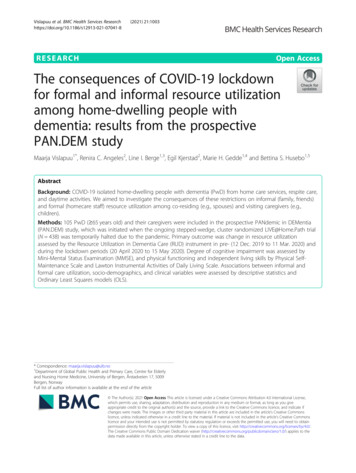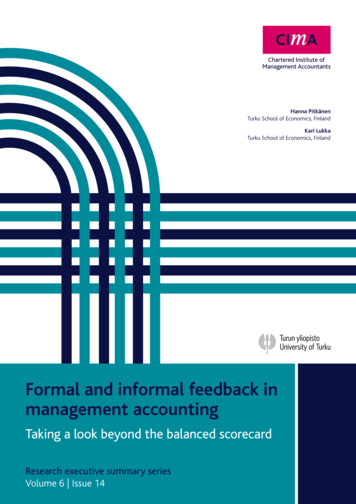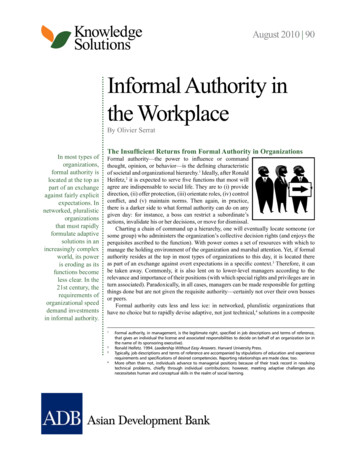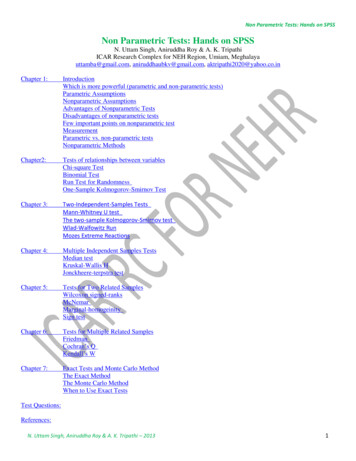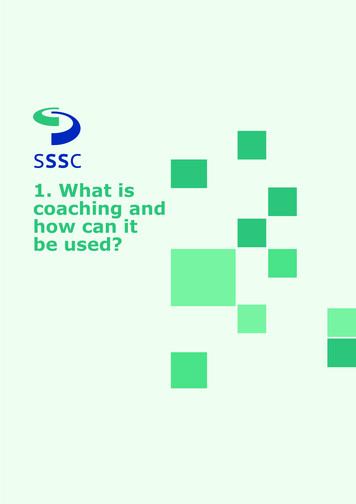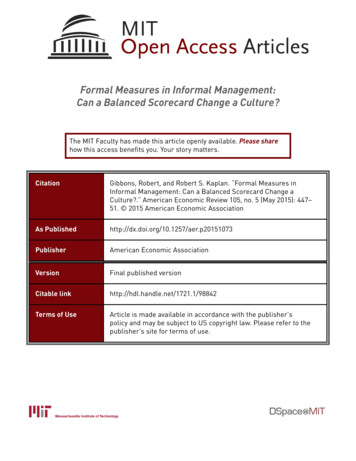
Transcription
Formal Measures in Informal Management:Can a Balanced Scorecard Change a Culture?The MIT Faculty has made this article openly available. Please sharehow this access benefits you. Your story matters.CitationGibbons, Robert, and Robert S. Kaplan. “Formal Measures inInformal Management: Can a Balanced Scorecard Change aCulture?.” American Economic Review 105, no. 5 (May 2015): 447–51. 2015 American Economic AssociationAs blisherAmerican Economic AssociationVersionFinal published versionCitable linkhttp://hdl.handle.net/1721.1/98842Terms of UseArticle is made available in accordance with the publisher'spolicy and may be subject to US copyright law. Please refer to thepublisher's site for terms of use.
American Economic Review: Papers & Proceedings 2015, 105(5): rmal Measures in Informal Management:Can a Balanced Scorecard Change a Culture?†By Robert Gibbons and Robert S. Kaplan*Since at least Holmstrom (1979), agency theorists and managerial accountants have analyzedwhat kinds of performance measures should beused in formal incentive contracts.1 For example, when Kaplan and Norton (1992, 1993,1996, 2001) proposed that company performance be measured with a “balanced scorecard”of both financial and non-financial measures,accounting scholars envisioned its role only informulaic compensation contracts.2We describe an alternative view of the scorecard, in which its formal measures are createdfor and used in informal management. By“informal” we do not mean casual, haphazard,or capricious behavior, but instead managerialbehavior not fully determined by rules or formulas—where executives use discretion andjudgment rather than managing solely “by thenumbers.” Examples of informal managementinclude adaptation, coordination, politics andinfluence, leadership, and informal authority.Section I of this essay extends the use of formal measures from formal to informal management. We review the role of formal measuresin formal agency contracts and then discussrelational incentive contracts that use informal weights on formal performance measures.More importantly, however, we depart fromagency models entirely by suggesting roles forformal measures in other models of informalmanagement.Section II is both more novel and morespeculative. Our focus shifts from using formalmeasures in informal management to developing informal management in the first place.Imposing ostensibly perfect measures on anorganization from outside can work less wellthan having key stakeholders participate indeveloping their own, potentially inferior, performance measures. In this sense, it is not theuse of a balanced scorecard but rather its internalcreation that can change an organization’s culture (defined below).I. Using Formal Measures in Formal andInformal ManagementMost models of performance measurementconcern agency problems.3 In actual practice ofcourse, managers use performance measures inmany ways beyond compensation. We thereforebegin with agency but then shift to other uses forperformance measures.A. Formal Measures in Agency Problems4Consider the following example of a formal measure in formal management.5 Anagent’s total contribution to firm value isy f 1 a 1 f 2 a 2 ε, whereas the agent’s measured performance is p g 1 a 1 g 2 a 2 ϕ.* Gibbons: Massachusetts Institute of Technology, 100Main Street, Cambridge, MA 02142 (e-mail: rgibbons@mit.edu); Kaplan: HBS, Soldiers Field, Boston, MA02163 (e-mail: rkaplan@hbs.edu). We are grateful to ElizaForsythe and Stephanie Hurder for research assistance, tothe MIT Sloan School’s Program on Innovation in Marketsand Organizations for financial support, and to NancyBeaulieu, Heikki Rantakari, and Tommy Wang for a decadeof instruction on these and related issues.†Go to http://dx.doi.org/10.1257/aer.p20151073 to visitthe article page for additional materials and author disclosure statement(s).1See Demski (2008) for a review.2For example, see Ittner, Larcker, and Rajan (1997) orLambert (2001).Again, see Demski (2008) for a review.Space constraints dictate that the descriptions of modelsbe terse and their analyses non-existent. On agency modelslike those described here, see Gibbons (2010, Section 2)for an introduction and Gibbons and Roberts (2013) for asurvey.5This basic model was developed by Feltham and Xie(1994) and is in the spirit of Holmstrom and Milgrom(1991) and Baker (1992).34447
448The agent’s total contribution to firm value, y,is too nuanced to be verifiable by an auditoror adjudicated by a court. The agent’s measured performance, p, however, is verifiable sothat compensation contracts can take the formw s bp. If both parties are risk-neutral,with payoffs Π y w to the principal andU w c( a 1 , a 2 ) to the agent, the optimalǁfǁbonus rate is b* cos(θ), where θ is theprefer informal weights on formal measures, tothe exclusion of any role for y.Finally, in multi-lateral relational contracting(such as between a principal and two agents), ifagent i’s output y i is not observable to agent j,the parties might again prefer informal weightson formal measures, such as β ( σ i ) p i , if σ i and p i are commonly observed by all three parties.7ǁgǁangle between the coefficient vectors f and g.Even in formal management, we can modelhow a balanced scorecard might be superiorto purely financial measures. For example,the principal can pay k to change from p to anew measure q that has a smaller θ . Anotherapproach (which surfaces the idea that a scorecard contains multiple measures) is to imaginethat paying k makes not only p but also q available, so that both measures can be used in theagent’s compensation formula.As a first example of informal management(but still within an agency setting), we turn fromformal to relational incentive contracts.6 In arepeated version of the setting above, the partiesmay be able to utilize y, even though it is notan auditable performance measure. Consider therelational incentive contract w s B(y). Thefirst-best bonus function would be B(y) y, butthis bonus will not be feasible if the parties aretoo impatient, so the second-best equilibrium inthe repeated game will entail B(y) y.This model of relational incentive contractsdescribes informal measures used in informalmanagement. Formal measures could be addedin several ways. Most simply, one could combine the two models above: w s bp B(y).More realistically, there could be a vector p ofperformance measures (as in a scorecard), notjust a single measure p.Continuinginthisvein,considerinformal weights on formal measures:w s bp B(y) β (σ)p , where σ is a signal that each party commonly observes but anauditor or court cannot. In fact, if y were “subjective” (i.e., observed by only the principal)then needing to induce the principal to reveal ywould create inefficiencies, so the parties mightB. Beyond AgencyOrganizations also use performance measures in many important roles beyond incentivecontracting. Case studies of such uses includethe interactive budgeting system at Johnsonand Johnson (Simons 2000), benchmarking ofclinical outcomes at a surgical practice (Porter,Deerberg-Wittram, and Marks 2014), aligningbranded gasoline stations to a common valueproposition (Kaplan 1996), and communicating customer-service goals to bank employees(Campbell and Kazan 2014).These and other uses of performance measures (and information systems more generally)relate to the growing literature on information and decisions in organizations.8 Gibbons,Matouschek, and Roberts (2013)—henceforth,GMR—provide the following simple frameworkthat nests many models from this literature:(i) The state of the world s S is drawnfrom the distribution f(s) .(ii) Player 1 privately observes the signal θ drawn from the distribution g(θ s) .(iii) Player 1 chooses an influence action a A .(iv) Player 2 privately observes the signal σ drawn from the distribution h(σ s, a) .(v) Player 2 chooses a decision d D .(vi) The players receive payoffs Ui (s, a, d) for i 1, 2.See Baker, Gibbons, and Murphy (1994); Fuchs (2007);and Levin (2002) for models that have been or could beelaborated in these directions.8See Gibbons (2010, Section 3) for an introduction.76MAY 2015AEA PAPERS AND PROCEEDINGSThe classic models are MacLeod and Malcomson(1989) and Levin (2003). See Malcomson (2013) for asurvey.
VOL. 105 NO. 5FORMAL MEASURES IN INFORMAL MANAGEMENTProminent applications of this frameworkconcern politics and influence, leadership, coordination, and informal authority.9 Two pointsare more important for present purposes: (i)these are models of informal management10 and(ii) the framework can be used to explore therole of formal measures in such models.As just one illustration of the latter, consider specializing the framework to analyzeadaptation and coordination.11 Let the state ofthe world have two dimensions: s ( s 1 , s 2 ),where s i s 0 ε i , and let θ s 1 and σ s 2 .Consider a team-theoretic model: U(s, a, d) α(a s 1 )2 γ (a d)2 α(d s 2 )2 forboth players, where α reflects the importance ofadaptation and γ of coordination.In this setting, it is easy to imagine an organization paying cost k to create a public signal η s 0 ξ in stage (1). In addition, onecould improve player i’s information about s j ,although the importance of coordination maylimit how much information it is useful to convey to individual decision-makers. Finally, if theplayers did not have identical interests, giventhe inefficiencies that arise in signaling modelsand the like, there could be roles for informationsystems that reduce the information available tointerested parties.12In sum, this subsection surfaces the importance of informal management beyond incentivecontracting. More importantly, its primary purpose has been to highlight the potential roles offormal measures for informal management. Weenvision a rich research stream that asks questions like Holmstrom’s (1979)—namely, howwould one use a new performance measure and,hence, what value would it create?9See Milgrom and Roberts (1988); Hermalin (1998);and Aghion and Tirole (1997) for specific models, GMRSection 2 for further interpretations, and GMR Section 3 forenrichments.10To repeat, our definition of an informal managementprocess is one where managerial behavior is not fullydetermined by rules, formulas, or contracts. In a model,one can tell that a decision is chosen informally if it isfreely chosen rather than determined by a rule, formula, orcontract—none of which appear in the framework.11See Dessein and Santos (2006); Alonso, Dessein,and Matouschek (2008); and Rantakari (2008) for richertreatments.12See Section 4 of GMR for existing work in this vein.449II. Developing Informal ManagementAn even more ambitious agenda asks howinformal management arises in the first place.Rather than parachuting formal measures into afirm, managers who develop a balanced scorecard internally can discuss both why certain measures should be selected and how they should beused. The benefit from such a development process was articulated well by Brian Baker, CEOof Mobil US Marketing and Refining, after sixyears of successful strategy execution with thebalanced scorecard:You could take our scorecard and give itto a competitor and it wouldn’t work. Youhad to have sweated through the hoursand hours of work and effort that wentbehind the card to get the benefits from themeasures. That’s what brings it to life. It’sgot to become part of the company’s beliefsystem, almost a religion—the benefitsdon’t come just from having a piece ofpaper with a scorecard on it.13Kaplan and Norton (1992, 1993) envisioneda firm that already had a well-understood strategy. The firm selected financial and nonfinancialmeasures in a balanced scorecard to (i) allocateresources toward implementing the strategy,(ii) empower decentralized decision-makers toadapt to local conditions while remaining coordinated around the overarching strategy (as inthe example above), and (iii) assess the performance of divisions and managers. Even in thissetting, where the firm has a well-understoodstrategy, developing the scorecard internallycommunicates and builds agreement on how thescorecard measures will be used.Kaplan and Norton (1996, 2001) extendedthese ideas by considering a firm that does notyet have agreement about its strategy. Its internal development of a scorecard involved activedebates about the strategy’s objectives and measures, including why certain measures wereselected and others excluded.Brian Baker’s comment illustrates that theprocess of developing the strategy’s performance measures gives clarity to the strategy,helps to create a consensus among the executiveteam about the strategy and how it will be imple13Baker (2000).
450AEA PAPERS AND PROCEEDINGSmented, and builds understanding about howexecutive performance will be evaluated. In thespirit of Gibbons and Henderson (2013), theseoutcomes of developing a scorecard internallyare examples of management practices that relyon relational contracts among the members ofthe executive team. As Gibbons and Hendersonargue, such relational contracts require both“task” knowledge (of what is supposed to bedone) and “relational” knowledge (of how managers should react after unanticipated eventsoccur).Viewed through the lens of relational contracting, developing a scorecard of formalmeasures internally creates not only the formal measures themselves but also agreementamong the participants about how the measureswill be used in informal management. In thissense, the internal development of the scorecardhelps to create a new corporate culture alignedto the strategy, where we define “culture” asdescribed by Schein (2010)—shared assumptions about: mission, strategy, and goals; themeans to achieve the goals; the measurement ofresults; and how to react when things do not goaccording to plan. We eagerly await new modelsof how the development and use of performancemeasures can play these complex roles in informal management.REFERENCESAghion, Philippe, and Jean Tirole. 1997. “Formaland Real Authority in Organizations.” Journalof Political Economy 105 (1): 1–29.Alonso, Ricardo, Wouter Dessein, and NikoMatouschek. 2008. “When Does CoordinationRequire Centralization?” American EconomicReview 98 (1): 145–79.Baker, Brian. 2000. Speech presented at BalancedScorecard Collaborative Conference. Boston,MA.Baker, George P. 1992. “Incentive Contracts andPerformance Measurement.” Journal of Political Economy 100 (3): 598–614.Baker, George, Robert Gibbons, and Kevin J.Murphy. 1994. “Subjective Performance Mea-sures in Optimal Incentive Contracts.” Quarterly Journal of Economics 109 (4): 1125–56.Campbell, Dennis, and Brent Kazan. 2014. “TDCanada Trust.” Harvard Business School Case110-049.MAY 2015Demski, Joel S. 2008. Managerial Uses ofAccounting Information. 2nd ed. New York:Springer.Dessein, Wouter, and Tano Santos. 2006. “Adaptive Organizations.” Journal of Political Economy 114 (5): 956–95.Feltham, Gerald A., and Jim Xie. 1994. “Performance Measure Congruity and Diversityin Multi-Task Principal/Agent Relations.”Accounting Review 69 (3): 429–53.Fuchs, William. 2007. “Contracting with RepeatedMoral Hazard and Private Evaluations.” American Economic Review 97 (4): 1432–48.Gibbons, Robert. 2010. “Inside Organizations:Pricing, Politics, and Path Dependence.”Annual Review of Economics 2 (1): 337–65.Gibbons, Robert, and Rebecca Henderson. 2013.“What Do Managers Do?” In The Handbookof Organizational Economics, edited by R.Gibbons and J. Roberts, 680–731. Princeton:Princeton University Press.Gibbons, Robert, Niko Matouschek, and JohnRoberts. 2013. “Decisions in Organizations.”In The Handbook of Organizational Economics, edited by R. Gibbons and J. Roberts, 373–431. Princeton: Princeton University Press.Gibbons, Robert, and John Roberts. 2013. “Economic Theories of Incentives in Organizations.” In The Handbook of OrganizationalEconomics, edited by R. Gibbons and J. Roberts, 56–99. Princeton: Princeton UniversityPress.Hermalin, Benjamin E. 1998. “Toward an Economic Theory of Leadership: Leading byExample.” American Economic Review 88 (5):1188–206.Holmstrom, Bengt. 1979. “Moral Hazard andObservability.” Bell Journal of Economics 10(1): 74–91.Holmstrom, Bengt, and Paul Milgrom. 1991.“Multitask Principal-Agent Analyses: Incentive Contracts, Asset Ownership, and JobDesign.” Journal of Law, Economics, andOrganization 7: 24–52.Ittner, Christopher D., David F. Larcker, and Madhav V. Rajan. 1997. “The Choice of Perfor-mance Measures in Annual Bonus Contracts.”Accounting Review 72 (2): 231–55.Kaplan, Robert S. 1996. “Mobil USM&R: Linking the Balanced Scorecard.” Harvard Business School Case 197-025.Kaplan, Robert S., and David P. Norton. 1992.“The Balanced Scorecard: Measures that Drive
VOL. 105 NO. 5FORMAL MEASURES IN INFORMAL MANAGEMENTPerformance.” Harvard Business Review 70(1): 71–9.Kaplan, Robert S., and David P. Norton. 1993.“Putting the Balanced Scorecard to Work.”Harvard Business Review 71 (5): 134–47.Kaplan, Robert S., and David P. Norton. 1996.The Balanced Scorecard: Translating StrategyInto Action. Boston: Harvard Business SchoolPress.Kaplan, Robert S., and David P. Norton. 2001.The Strategy-Focused Organization: How Balanced Scorecard Companies Thrive in the NewBusiness Environment. Boston: Harvard Business School Press.Lambert, Richard A. 2001. “Contracting Theoryand Accounting.” Journal of Accounting andEconomics 32: 3–87.Levin, Jonathan. 2002. “Multilateral Contractingand the Employment Relationship.” QuarterlyJournal of Economics 117 (3): 1075–103.Levin, Jonathan. 2003. “Relational IncentiveContracts.” American Economic Review 93(3): 835–57.MacLeod, W. Bentley, and James M. Malcomson.4511989. “Implicity Contracts, Incentive Compatibility, and Involuntary Unemployment.”Econometrica 57 (2): 447–80.Malcomson, James. 2013. “Relational IncentiveContracts.” In The Handbook of Organizational Economics, edited by R. Gibbons and J.Roberts, 1014–65. Princeton: Princeton University Press.Milgrom, Paul, and John Roberts. 1988. “AnEconomic Approach to Influence Activities inOrganizations.” American Journal of Sociology 94: S154–S79.Porter, Michael E., Jens Deerberg-Wittram, andClifford Marks. 2014. “Martini Klinik: Pros-tate Cancer Care.” Harvard Business SchoolCase 714-471.Rantakari, Heikki. 2008. “Governing Adaptation.” Review of Economic Studies 75 (4):1257–85.Schein, Edgar H. 2010. Organizational Cultureand Leadership. San Fransisco: Jossey-Bass.Simons, Robert L. 2000. “Codman & Shurtleff,Inc.: Planning and Control System.” HarvardBusiness School Case 187-081.
Can a Balanced Scorecard Change a Culture?† By Robert Gibbons and Robert S. Kaplan* *Gibbons: Massachusetts Institute of Technology, 100 Main Street, Cambridge, MA 02142 rgibbons@(e-mail: mit.edu); Kaplan: HBS, Soldiers Field, Boston, MA 02163 (e-mail: rkaplan@hbs.edu). We are grateful to Eliza Forsythe and Stephanie Hurder for research .
